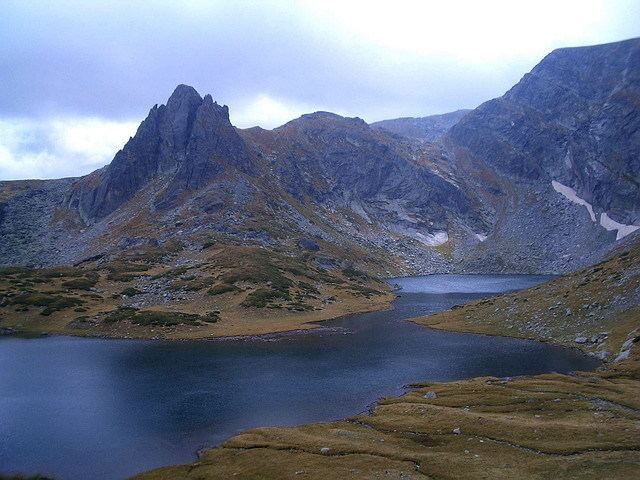Area 2,629 km² Types of rock Granite, Gneiss, Marble | Elevation 2,925 m | |
 | ||
Similar | ||
Musala peak 2925m 9 596 ft rila mountain bulgaria
Rila (Bulgarian: Рила, [ˈriɫɐ]) is a mountain range in southwestern Bulgaria and the highest mountain range of Bulgaria and the Balkans, with its highest peak being Musala at 2,925 m. The massif is also the sixth highest mountain in Europe (when each mountain is represented by its highest peak only), coming after the Caucasus, the Alps, Sierra Nevada, the Pyrenees and Mount Etna, and the highest between the Alps and the Caucasus. More than one-third of the mountain is occupied by the Rila National Park, the rest lies within the Rila Monastery Nature Park.
Contents
- Musala peak 2925m 9 596 ft rila mountain bulgaria
- Map of Rila 2011 Bulgaria
- Holidays rila mountains bulgaria
- Geology
- Borders and climate
- Flora Fauna
- List of mammals in National park Rila
- Subdivision
- Peaks in Rila
- Trivia
- References
Map of Rila, 2011, Bulgaria
The mountain is believed to have been named after the river of the same name, which comes from the Old Bulgarian verb "рыти" meaning "to grub".
Rila is abundant in glacial lakes (about 200) and hot springs in fault areas at the base of the mountain. Some of the Balkans' longest and deepest rivers originate from Rila, including Maritsa, Iskar and Mesta.
Culturally, Rila is famous for the Rila Monastery, Bulgaria's largest and most important monastery, founded in the 10th century by Saint John of Rila. Alongside the cultural landmarks the mountain is also famous for the Seven Rila Lakes.
Holidays rila mountains bulgaria
Geology
Rila is a dome-shaped horst mountain, part of the Balkans' oldest land, the Macedono-Thracian Massif. It was formed by granite and gneiss rocks and crystal schists during the Paleozoic (250,000,000 years ago). Rila's alpine relief was formed during the Pleistocene by a series of glacial periods. During the most recent, so-called Würm glaciation, 10-12,000 years ago the permanent snow line was at 2,100 m above sea level. Above this line glaciers radically changed the existing relief, carving out deep cirques, sharp pyramid-shaped peaks, rock pinnacles, various valleys, moraines and other typical glacial formations.
Borders and climate
Rila has an area of 2,400 km². The dome of the mountain rises over the surrounding mountain valleys, with the Borovets Saddle (1,305 m) connecting the main Musala Ridge with the Shipochan and Shumnatitsa ridges that connect to the Ihtiman Sredna Gora mountains through the Gate of Trajan pass. The Yundola Saddle (1,375 m) and the Avramovo Saddle (1,295 m) link Rila with the Rhodopes to the east, while the connection with Pirin is the Predel Saddle (1,140 m), the one with Verila being the Klisura Saddle (1,025 m).
The climate is typically alpine, with 2,000 mm of precipitation on Musala yearly, about half of which is snow. The lowest average temperature ever measured in February on Musala is –11.6 °C and the absolute minimum is -31.2 °C. An average temperature for August is 5.4 °C, the maximum being 18.7 °C.
Flora & Fauna
The flora of Rila contains three local endemics which are seen only in this mountain. These plants are Primula deorum (with the largest population), Rheum rhaponticum and Alchemilla pawlowskii. In the mountain thrives also 36 plants as Campanula lanata, Centaurea mannagettae which are endemic for the Balkans. Some of the plant species have survived the last glacial period by turning into relict organisms.
Some of the animals, which live in Rila, are in danger as well. 24 of the species that inhabit Rila are listed in the IUCN Red List of Threatened Species. There are 172 types of vertebrates living in Rila and 121 of them are registered in the Bulgarian Red List of Threatened Species, 15 are recorded in the European Red List of Threatened Species, 24 are listed in the International Union for Conservation of Nature and 158 of 172 are included in the Bern Convention lists. Such animals are Barbus cyclolepis (which is rare because of the habitat loss and the river pollution), Triturus alpestris, Spermophilus citellus (European Ground Squirrel) and others.
List of mammals in National park Rila
There are 48 mammal species in National park Rila
Insectivores
• Eastern European hedgehog
• Shrew
Bats
• Bats
Lagomorphs
• European rabbit
Rodents
• Wild mice
• Vole
• Water vole
• Spermophilus citellus
Carnivores
• Grey wolf
• Red fox
• Marten
• Eurasian badger
• Least weasel
• European otter
• Brown bear
• Wild cat
Even-toed ungulates
• Wild boar
• Roe deer
• Red deer
• Alpine ibex
• Wild goat
Subdivision
Rila is subdivided into several parts depending on their geographic position.
Peaks in Rila
Trivia
Rila Point on Livingston Island in the South Shetland Islands, Antarctica is named after Rila Mountain.
